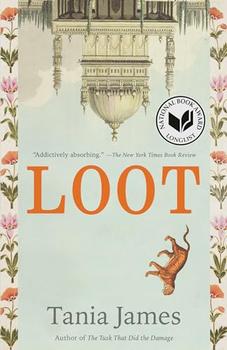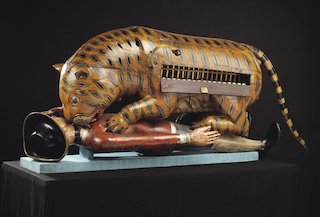Summary | Excerpt | Reading Guide | Reviews | Beyond the Book | Read-Alikes | Genres & Themes | Author Bio

A Novel
by Tania JamesThis article relates to Loot
 Central to the plot of Loot is the magnificent Tipu's Tiger, the wooden automaton that Abbas, a young Muslim woodcarver, creates in the 1790s in collaboration with the French inventor and clock maker Lucien Du Leze at the request of their ruler, Tipu Sultan.
Central to the plot of Loot is the magnificent Tipu's Tiger, the wooden automaton that Abbas, a young Muslim woodcarver, creates in the 1790s in collaboration with the French inventor and clock maker Lucien Du Leze at the request of their ruler, Tipu Sultan.
According to the Mechanical Art and Design Museum (MAD), the word automata (the plural of automaton) is taken from the Greek word αὐτόματα, or "acting of one's own will." An automaton is a moving, mechanical device, usually constructed to look like a human or animal figure, which uses a variety of mechanical systems to give the illusion of autonomous movement. Automata made before the 16th century have not survived, but we know from written designs that early versions existed quite far back in antiquity. Examples have been traced back to the Greeks, the Chinese and the royal courts of the Islamic world.
Although Loot is a work of fiction, and the craftsmen Abbas and Lucien Du Leze are characters sprung from the imagination of author Tania James, Tipu's Tiger exists, as did the ruler it was named for, Tipu Sultan Fateh Ali Khan (also known as the Tiger of Mysore).
Tipu's Tiger is a carved lifelike figure of a tiger fiercely pinning a British soldier. Its body is a hollowed-out space in which bellows and a pipe organ have been inserted so that when the organ is played, the tiger gives out ferocious growls and the man screams and waves an arm. It must have created quite a stir when it was first introduced to the sultan's palace.
In the novel, after the British have killed the sultan and looted his palace, the automaton is given to one of the British officers and sent to his estate in England, but the real tiger was sent directly to the London headquarters of the British East India company and displayed in the company's India Museum. After that museum closed, it was transferred in the 1880s to the South Kensington Museum, now called the Victoria and Albert Museum. There, other than a brief period during the Second World War, it has been on display to the public ever since.
In her book Tipu's Tigers (2009) Susan Stronge quotes an employee of the East India Company indignantly describing the automaton as follows:
This piece of mechanism represents a royal Tyger in the act of devouring a prostrate European…The whole of this design was executed by Order of Tippoo Sultaun. It is imagined that this memorial of the arrogance and barbarous cruelty of Tippoo Sultan may be thought deserving of a place in the Tower of London.
The employee does not seem to recognize the irony of his words, as Tipu's unfortunate end demonstrates that he was not so very wrong to distrust the British. Nevertheless, his tiger was considered to be a terrible afront to the British. So much so, that, according to the Victoria and Albert Museum, they arranged to have the last word on the matter:
After the British victory, a medal was struck in England to be given to every East India Company soldier who had taken part in the Siege of Seringapatam. On one side, a snarling, powerfully built lion is shown forcing a violently resisting tiger to the ground. Above them, a banner bearing the Union flag proclaims in Arabic Assadullah al-Ghaleb, "the conquering lion of God," borrowing the idea of Tippoo's tiger but leaving no doubt that here, the British lion defeats the "Tiger of Mysore."
Tipu's Tiger figure showing organ keyboard, courtesy of Victoria and Albert Museum
Filed under Music and the Arts
![]() This article relates to Loot.
It first ran in the August 2, 2023
issue of BookBrowse Recommends.
This article relates to Loot.
It first ran in the August 2, 2023
issue of BookBrowse Recommends.
Your guide toexceptional books
BookBrowse seeks out and recommends the best in contemporary fiction and nonfiction—books that not only engage and entertain but also deepen our understanding of ourselves and the world around us.